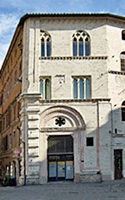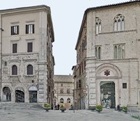
The Collegio dei Notai (notaries’ guild) commissioned this palace (adjoining and to the left of Palazzo Capocci) following the demolition of its earlier premises near the Duomo. The guild also owned the Chiesa e Ospedale di Santa Maria Annunziata in what is now Corso Garibaldi from at least the 14th century.

The guild, which had purchased the ex- Sala del Consiglio of Palazzo dei Priori in 1583, also continued to use the remaining part of the Collegio dei Notai until 1599. (The ex- Sala del Consiglio of Palazzo dei Priori became known as the Sala dei Notai).
The guild sold the carved the benches (1462) by Costanzo di Mattiolo from its original Sala dell' Udienza to the Collegio della Mercanzia in 1865.
The residual part of the palace is now used as a shop. The surviving part of its facade contains one complete trifore window and part of another in each of its two upper storeys. The arms of the guild (an ink pot and two goose feather quills) can be seen between the lower set of windows. What was the central portal (1444) was moved to its current location during the partial demolition of the palace in 1591.
Art from the Collegio dei Notai
Annunciation with St Luke (ca. 1450)

The co-patrons of the guild were the Virgin Annunciate and St Luke, and this determined the subject of the altarpiece. The Annunciation is set in a Renaissance palace, presumably intended to represent the Virgin’s home. God the Father in a mandorla of seraphim appears against a golden sky above a rocky landscape, surrounded by flying angels, and sends the Holy Spirit towards the Virgin in the form of a dove. St Luke (with the ox that is his usual attribute) squats between the Virgin and the angel Gabriel and records the miracle for his Gospel, as a good notary would. The original predella, which depicted the Pietà with SS Mark and Jerome, still survived in 1822 but was subsequently lost.
Annunciation (1525-8)
This altarpiece, which is signed by Sinibaldo Ibi and dated 1528, was commissioned by the procurators of the Ospedale di Santa Maria Annunziata, the hospice owned by the Collegio dei Notai. It was destined for the chapel in the hospice. On receipt of the altarpiece, the procurators commissioned its frame from Giovanni Battista Bastoni, to a design by Sinibaldo Ibi.
The altarpiece was subsequently moved to the Collegio dei Notai, probably in 1588 before that building was partly demolished, changing places with another altarpiece of the same subject that is attributed to Benedetto Bonfigli (above). The altarpiece by Sinibaldo Ibi seems to have returned to its original location in the early 19th century, and entered the Galleria Nazionale in 1863. Its original frame no longer survives.



